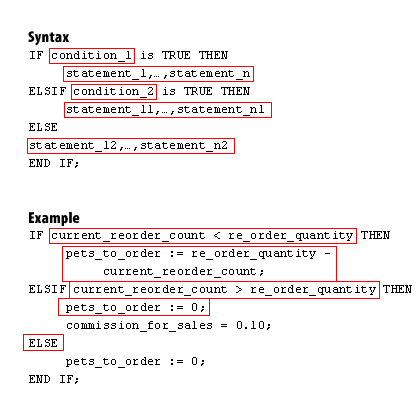If_then_else syntax

IF condition_1 is TRUE THEN statement_1, ..., statement_n ELSEIF condition_2 is TRUE THEN statement_11,...,statement_n1 ELSE statement_12,...,statement_n2 END IF;If_then_else syntax
- condition_1: First condition that will be evaluated.
- condition_2: Next condition that will be evaluated.
- statement_1,...,statement_n: A sequence of statements that PL/SQL will execute if condition_1 evaluates to TRUE.
- statement_11,...,statement_n1: A sequence of statements that PL/SQL will execute if condition_2 evaluates to TRUE.
- statement_12,...,statement_n2: A sequence of statements that PL/SQL will execute if both condition_1 and condition_2 evaluate to FALSE.
- current_reorder_count < re_order_quantity: First condition that will be evaluated.
- pets_to_order := re_order_quantity - current_reorder_count
This statement will be executed if the value of current_reorder_count is less than the value of re_order_quantity.
Oracle PL/SQL Programming
Short-Circuit Evaluation
When evaluating a logical expression, PL/SQL uses short-circuit evaluation. That is, PL/SQL stops evaluating the expression as soon as it can determine the result. Therefore, you can write expressions that might otherwise cause errors. In Example 4, short-circuit evaluation prevents the OR expression from causing a divide-by-zero error. When the value of on_hand is zero, the value of the left operand is TRUE, so PL/SQL does not evaluate the right operand. If PL/SQL evaluated both operands before applying the OR operator, the right operand would cause a division by zero error.
Example 4: Short-Circuit Evaluation
DECLARE
on_hand INTEGER := 0;
on_order INTEGER := 100;
BEGIN
-- Does not cause divide-by-zero error;
-- evaluation stops after first expression
IF (on_hand = 0) OR ((on_order / on_hand) < 5) THEN
DBMS_OUTPUT.PUT_LINE('On hand quantity is zero.');
END IF;
END;
/
Result: On hand quantity is zero.
